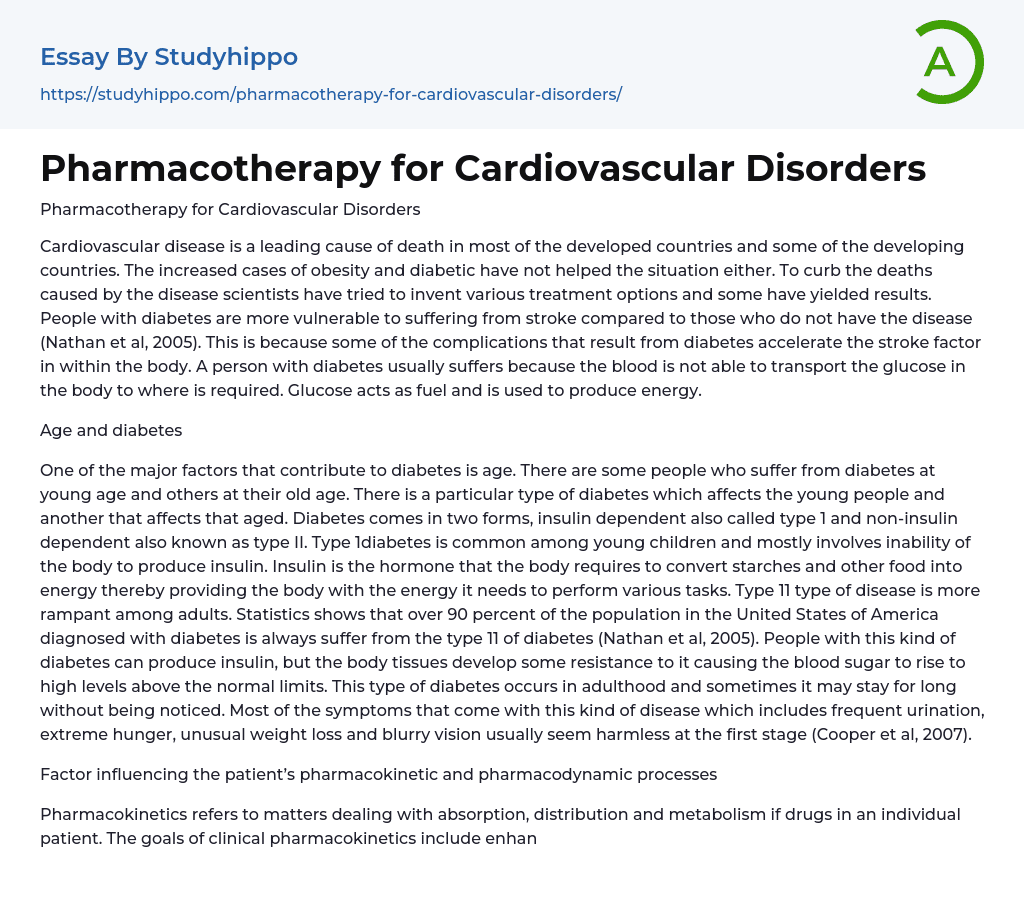

Pharmacotherapy for Cardiovascular Disorders Essay Example
Pharmacotherapy for Cardiovascular Disorders
The worldwide impact of cardiovascular disease as a leading cause of death is not dependent on a country's level of development. The prevalence of obesity and diabetes has only worsened the situation. To combat this condition and lower mortality rates, researchers have created several treatment options that have demonstrated encouraging outcomes. It is important to recognize that individuals with diabetes face a greater stroke risk compared to those without the disease (Nathan et al, 2005).
People with diabetes are at a higher risk of stroke because complications arising from the disease hinder the delivery of glucose to vital areas in the body, which is necessary for energy production.
Age's Influence on Diabetes
The onset of diabetes is significantly impa
...cted by age.
Diabetes can affect people at different stages of life. Some people develop diabetes in their youth, while others are affected later in life. There are two main types of diabetes: type 1, also known as insulin dependent, and type 2, which is referred to as non-insulin dependent. Type 1 diabetes is often seen in young children and is characterized by the body's inability to produce insulin. Insulin is important for converting food into energy and allowing the body to function properly. On the other hand, type 2 diabetes is more common among adults.
According to statistics, the majority of people diagnosed with diabetes in the United States have type 2 diabetes (Nathan et al, 2005). Type 2 diabetes is a condition that typically develops in adulthood and is characterized by insulin resistance, which leads to high blood sugar levels.
Common symptoms include frequent urination, excessive hunger, weight loss, and blurry vision (Cooper et al, 2007).
Factors affecting the pharmacokinetic and pharmacodynamic processes in patients
Pharmacokinetics refers to how drugs are absorbed, distributed, and metabolized within an individual. The main objectives of clinical pharmacokinetics are to enhance the effectiveness of drug therapy and reduce drug toxicity levels for patients.
People with diabetes are at a higher risk of having a stroke due to the presence of hypertension, or high blood pressure. Roughly two-thirds of adults with diabetes have high blood pressure, and if it is not effectively controlled, it can lead to a stroke.
Heart attack and irregular heartbeat are common in people with diabetes, increasing the risk of stroke (Nathan et al, 2005).
The impact of changes in pharmacokinetic and pharmacodynamic processes on recommended drug therapy for patients
While age has minimal effect on drug absorption, it is observed that older patients may experience greater effects from the pharcokinetics of certain drugs, making concentration determination challenging. Both types of diabetes can be managed to reduce long-term health complications like stroke. Type 1 diabetes requires monitoring blood sugar levels and daily insulin injections. Type 2 diabetes, which is exacerbated by obesity, can be controlled through weight loss, regular exercise, and adopting healthy eating habits and diets.
Controlling and preventing diabetes can greatly reduce the risk of stroke (Cooper et al, 2007). It is essential to have regular eye check-ups with a doctor to promptly identify any abnormalities and treat diabetes. Early detection of diabetes is crucial as it can lead to treatable eye diseases.
References
- Nathan, D. M., Cleary, P. A., Backlund, J. Y., Genuth, S. M., Lachin, J.
The Epidemiology of Diabetes
Interventions and Complications (DCCT/EDIC) Study Research Group conducted a study to investigate the relationship between intensive diabetes treatment and cardiovascular disease in patients with type 1 diabetes. The study, authored by M. Orchard, T. J., Zinman, B., and Cooper, L., was published in the New England Journal of Medicine in 2005.
T., Baughman, K. L., Feldman, A. M., Frustaci, A., Jessup, M., Kuhl, U., ... ; Virmani, R. (2007). The role of endomyocardial biopsy in the management of cardiovascular disease: a scientific statement from the American Heart Association, the American College of Cardiology, and the European Society of Cardiology Endorsed by the Heart Failure Society of America and the Heart Failure Association of the European Society of Cardiology. Journal of the American College of Cardiology, 50(19), 1914-1931.
- Food essays
- Genetically Modified Organisms essays
- Child Development essays
- Eating essays
- Breakfast essays
- Genetically Modified Food essays
- Milk essays
- Chewing gum essays
- Energy Drink essays
- Caffeine essays
- Chocolate essays
- vegetarian essays
- Weight Loss essays
- Anorexia essays
- Metabolism essays
- Diet essays
- Vitamin essays
- Dieting essays
- Junk Food essays
- Eating Habits essays
- Food Safety essays
- Food Security essays
- Beverages essays
- Cuisines essays
- Dairy essays
- Desserts essays
- Fast Food essays
- Bread essays
- Meal essays
- Meat essays
- Organic Food essays
- Rice essays
- Sugar essays
- Taste essays
- Beef essays
- Coconut essays
- Crowd essays
- Dinner essays
- Juice essays
- Sainsbury essays
- Cooking essays
- Ginger essays
- Oreo essays
- Drink essays
- Beer essays
- Wine essays
- Coffee essays
- Tea essays
- Cake essays
- Hamburger essays



